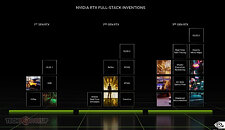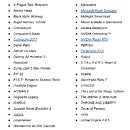- Joined
- Oct 9, 2007
- Messages
- 47,411 (7.51/day)
- Location
- Hyderabad, India
| System Name | RBMK-1000 |
|---|---|
| Processor | AMD Ryzen 7 5700G |
| Motherboard | ASUS ROG Strix B450-E Gaming |
| Cooling | DeepCool Gammax L240 V2 |
| Memory | 2x 8GB G.Skill Sniper X |
| Video Card(s) | Palit GeForce RTX 2080 SUPER GameRock |
| Storage | Western Digital Black NVMe 512GB |
| Display(s) | BenQ 1440p 60 Hz 27-inch |
| Case | Corsair Carbide 100R |
| Audio Device(s) | ASUS SupremeFX S1220A |
| Power Supply | Cooler Master MWE Gold 650W |
| Mouse | ASUS ROG Strix Impact |
| Keyboard | Gamdias Hermes E2 |
| Software | Windows 11 Pro |
NVIDIA today announced NVIDIA DLSS 3, an AI-powered performance multiplier that kicks off a new era of NVIDIA RTX neural rendering for games and applications. DLSS 3 builds on the company's lead in AI-accelerated super-resolution techniques to deliver outstanding image quality and up to 4x the performance of brute-force rendering, plus the quick responsiveness that defines a comprehensive gaming experience.
The technology debuted today during the GeForce Beyond: Special Broadcast at GTC, which also introduced GeForce RTX 40 Series GPUs based on the new NVIDIA Ada Lovelace architecture. "DLSS is one of our best inventions and has made real-time ray tracing possible. DLSS 3 is another quantum leap for gamers and creators," said Jensen Huang, founder and CEO of NVIDIA. "Our pioneering work in RTX neural rendering has opened a new universe of possibilities where AI plays a central role in the creation of virtual worlds."

DLSS 3 is already receiving widespread support from the gaming ecosystem, with over 35 games and applications integrating the technology.
DLSS 3: The Performance Multiplier, Powered by AI
The combination of ray tracing and AI technologies has revolutionized video games by simultaneously delivering dramatic improvements in image quality along with massive uplifts in performance—a feat unheard of before GeForce RTX.
Powered by new fourth-generation Tensor Cores and a new Optical Flow Accelerator on GeForce RTX 40 Series GPUs, DLSS 3 is the latest iteration of the company's critically acclaimed Deep Learning Super Sampling technology and introduces a new capability called Optical Multi Frame Generation.
Optical Multi Frame Generation generates entirely new frames, rather than just pixels, delivering astounding performance boosts. The new Optical Flow Accelerator incorporated into the NVIDIA Ada Lovelace architecture analyzes two sequential in-game images and calculates motion vector data for objects and elements that appear in the frame, but are not modeled by traditional game engine motion vectors. This dramatically reduces visual anomalies when AI renders elements such as particles, reflections, shadows and lighting.
Pairs of super-resolution frames from the game, along with both engine and optical flow motion vectors, are then fed into a convolutional neural network that analyzes the data and automatically generates an additional frame for each game-rendered frame—a first for real-time game rendering. Combining the DLSS-generated frames with the DLSS super-resolution frames enables DLSS 3 to reconstruct seven-eighths of the displayed pixels with AI, boosting frame rates by up to 4x compared to without DLSS.
Because DLSS Frame Generation executes as a post-process on the GPU, it can boost frame rates even when the game is bottlenecked by the CPU. For CPU-limited games, such as those that are physics-heavy or involve large worlds, DLSS 3 allows the GeForce RTX 40 Series GPUs to render the game at up to twice the frame rate than the CPU is able to compute the game.
DLSS 3 integrations also incorporate NVIDIA Reflex, which synchronizes the GPU and CPU, ensuring optimum responsiveness and low system latency.
Game Developers Embrace DLSS 3, Over 35 Games, Applications Coming Soon
The revolutionary power of DLSS 3 is a boon for game developers who want to express their artistic vision. The technology is coming to the world's most popular game engines, such as Unity and Unreal Engine.
DLSS 3 has also received support from many of the world's leading game developers, with more than 35 games and applications announcing support, including:

Since DLSS 3 builds on top of DLSS 2 integrations, game developers can quickly enable it in existing titles that already support DLSS 2 or NVIDIA Streamline.
DLSS 3 Coming Oct. 12.
DLSS 3 is supported in GeForce RTX 40 Series GPUs and will debut on Oct. 12 with the availability of GeForce RTX 4090 GPUs. More details are available on GeForce.com or NVIDIA.com, including details on GeForce RTX 40 Series GPUs and NVIDIA DLSS technology.
View at TechPowerUp Main Site
The technology debuted today during the GeForce Beyond: Special Broadcast at GTC, which also introduced GeForce RTX 40 Series GPUs based on the new NVIDIA Ada Lovelace architecture. "DLSS is one of our best inventions and has made real-time ray tracing possible. DLSS 3 is another quantum leap for gamers and creators," said Jensen Huang, founder and CEO of NVIDIA. "Our pioneering work in RTX neural rendering has opened a new universe of possibilities where AI plays a central role in the creation of virtual worlds."

DLSS 3 is already receiving widespread support from the gaming ecosystem, with over 35 games and applications integrating the technology.
DLSS 3: The Performance Multiplier, Powered by AI
The combination of ray tracing and AI technologies has revolutionized video games by simultaneously delivering dramatic improvements in image quality along with massive uplifts in performance—a feat unheard of before GeForce RTX.
Powered by new fourth-generation Tensor Cores and a new Optical Flow Accelerator on GeForce RTX 40 Series GPUs, DLSS 3 is the latest iteration of the company's critically acclaimed Deep Learning Super Sampling technology and introduces a new capability called Optical Multi Frame Generation.
Optical Multi Frame Generation generates entirely new frames, rather than just pixels, delivering astounding performance boosts. The new Optical Flow Accelerator incorporated into the NVIDIA Ada Lovelace architecture analyzes two sequential in-game images and calculates motion vector data for objects and elements that appear in the frame, but are not modeled by traditional game engine motion vectors. This dramatically reduces visual anomalies when AI renders elements such as particles, reflections, shadows and lighting.
Pairs of super-resolution frames from the game, along with both engine and optical flow motion vectors, are then fed into a convolutional neural network that analyzes the data and automatically generates an additional frame for each game-rendered frame—a first for real-time game rendering. Combining the DLSS-generated frames with the DLSS super-resolution frames enables DLSS 3 to reconstruct seven-eighths of the displayed pixels with AI, boosting frame rates by up to 4x compared to without DLSS.
Because DLSS Frame Generation executes as a post-process on the GPU, it can boost frame rates even when the game is bottlenecked by the CPU. For CPU-limited games, such as those that are physics-heavy or involve large worlds, DLSS 3 allows the GeForce RTX 40 Series GPUs to render the game at up to twice the frame rate than the CPU is able to compute the game.
DLSS 3 integrations also incorporate NVIDIA Reflex, which synchronizes the GPU and CPU, ensuring optimum responsiveness and low system latency.
Game Developers Embrace DLSS 3, Over 35 Games, Applications Coming Soon
The revolutionary power of DLSS 3 is a boon for game developers who want to express their artistic vision. The technology is coming to the world's most popular game engines, such as Unity and Unreal Engine.
DLSS 3 has also received support from many of the world's leading game developers, with more than 35 games and applications announcing support, including:

Since DLSS 3 builds on top of DLSS 2 integrations, game developers can quickly enable it in existing titles that already support DLSS 2 or NVIDIA Streamline.
DLSS 3 Coming Oct. 12.
DLSS 3 is supported in GeForce RTX 40 Series GPUs and will debut on Oct. 12 with the availability of GeForce RTX 4090 GPUs. More details are available on GeForce.com or NVIDIA.com, including details on GeForce RTX 40 Series GPUs and NVIDIA DLSS technology.
View at TechPowerUp Main Site





